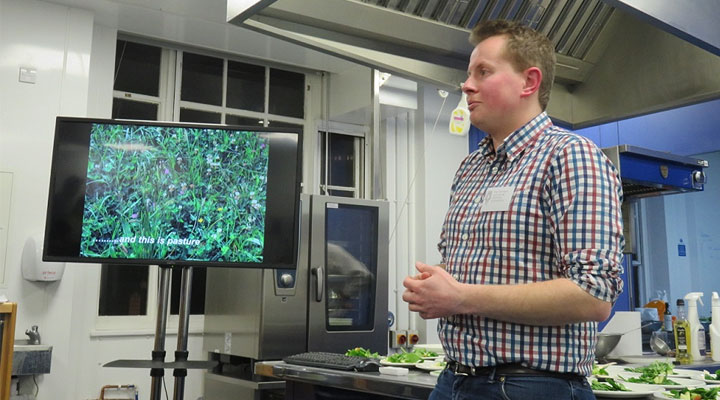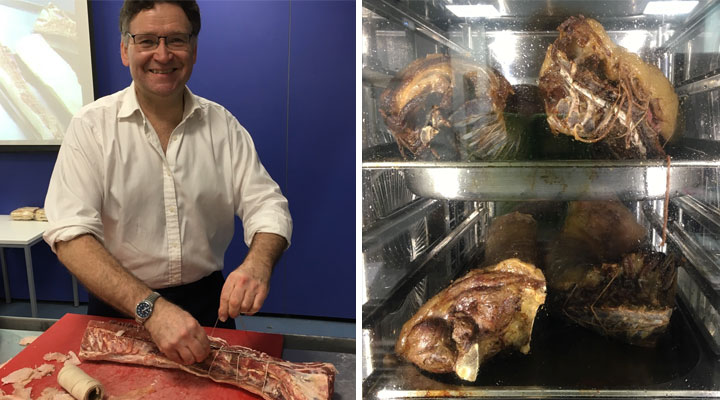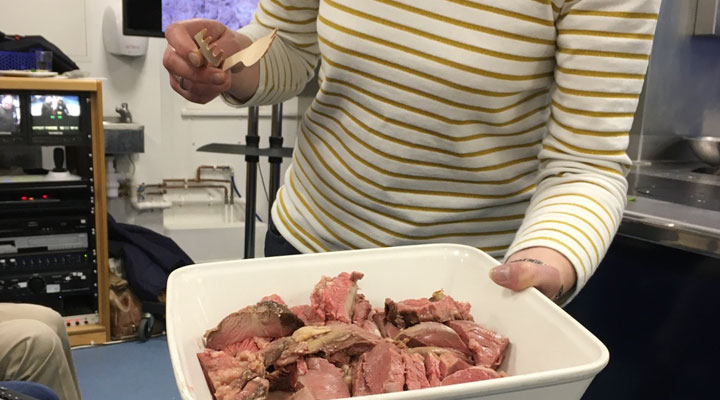All About Pasture-fed Mutton

At the end of January 50 or so Guild of Food Writers gathered at Westminster Kingsway College in Vincent Square, London to taste three loins of Pasture for Life mutton. Each was prepared and cooked exactly the same way, by expert chef Chris Trotter.
So what is mutton? Well it all depends on how many teeth a sheep has.
Lamb comes from a young sheep under 12 months of age, which does not have any permanent incisor teeth.
Hogget is a sheep of either sex having no more than two permanent incisors – usually between one to two years of age.
Mutton is from a female (ewe) or castrated male (wether) having more than two permanent incisors and is over two years old.
At the tasting, the three loins were from:
- A four year old Black Welsh Mountain sheep from Pen y Wyrlod farm, Abergavenny, Wales (blackwelshlamb.com)
- A two-year old Shetland sheep from Sheepdrove Organic Farm near Lambourn, Berkshire (sheepdrove.com)
- A seven year old Easycare ewe from Model Farm in Ross on Wye, in Herefordshire (modelfarm.org)
They were all hung for between two and four weeks.

Chris Trotter, trimmed off the skin, criss-crossed the fat and tied the loins individually together with string. He then blasted them for ten minutes at a high heat in the catering oven, before turning it down to 60°c for a slow cook for an hour.
The results were ‘extraordinary’ said Chris on tasting each of the samples as he cut the loins up into small pieces for everyone to try.
He could not believe how tender each and every one was – it was actually more tender than lamb – but with a lot more flavour he said.
The Farmers
Nick Miller explained that he has 40 to 50 different species of plants growing in his ancient welsh pastures, and the flavours come through in the taste of the meat. They sell their Pasture for Life mutton direct and to several high profile restaurants. They say that the feedback they receive often claims it is the best meat they have ever tasted.
Dan Bull from Sheepdrove said that their objective to sell their sheep as two year olds or older, specifically as mutton. They too have many species of plants growing in their pastures, which is reflected in how the mutton tastes. Dan says he and the butchers in the Sheepdrove shop in Maida Vale, urge consumers to eat mutton at Easter, not bland lamb.
Simon Cutter’s eight-year-old sheep had successfully given birth seven times in her life. But she had come to the point where she had lost all of her teeth, and was unable to graze. She too had only ever eaten herb-rich meadows all her life, self-medicating when she needed it and taking in the minerals and trace elements the deep-rooted plants had drawn up from the soil.
Magical Meat
In discussion during the tastings, the mutton was described as ‘sublimely silky’, and ‘minerally’ and ‘fresh herby’ and ‘unbelievably sweet’. Each one was different, reflecting the different areas of the country they had come from – but each one as equally delicious as the others.

Chris Trotter said it was really magical – to have the farmers here presenting their animals, describing how they had lived and what they had eaten.
“It is humbling to hear how a farmer has watched over and nurtured his sheep for so long – fed it well, with no grains and looked after it so well. The meat should be respected and the farmers paid for this.”
One of the most vociferous in his comments during the evening was Italian chef Giancarlo Caldesi, who was totally surprised at the taste, flavour and tenderness of all three pieces of mutton.
He has kindly invited the PFLA to carry out a tasting at his cookery school – La Cucina Caldesi in London. This is in the planning stages now.
With thanks to Hattie Ellis and the Guild of Food Writers, to the three Pasture for Life farmers and to Chris Trotter. Also thanks to Bob Kennard, author of Much ado about Mutton, who also gave a fascinating talk on the history of mutton.



